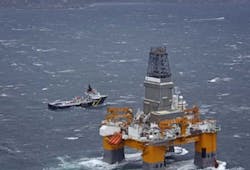UK set for upturn in offshore field development, exploration drilling
Offshore staff
LONDON — The U.K.’s North Sea Transition Authority (NSTA) says 33 new projects could go forward on the U.K. Continental Shelf (UKCS), based on its annual performance review for the U.K.’s top producers.
Collectively these would target 1.3 Bbbl of oil and gas.
By next year 890 MMbbl could be sanctioned for development. The NSTA added that it expects operators to rapidly deliver in the interest of U.K. supply resilience.
U.K. offshore exploration and appraisal should return to pre-pandemic levels, with 20 wells/year forecast for 2022-2024. The NSTA expects to stage a new licensing round later this year, subject to the government’s Climate Compatibility Checkpoint.
Carbon reduction efforts
In its Tier Zero meeting earlier this week with the sector’s 22 largest operators, officials stressed the need for continued proactive measures among operators to exceed emissions reduction targets agreed under the North Sea Transition Deal.
Data from the latest UKCS stewardship survey show that CO2 emissions for the U.K. upstream oil and gas industry fell 14% last year to 12.1 megatonnes, while flaring was 195 lower and venting was down by 24%.
Sustaining these levels may prove challenging this year, with U.K. gas production expected to rise.
The NSTA added that 80% of Tier Zero operators have forward plans covering asset upgrades, emissions reduction and platform electrification.
Various operators are participating in government-backed industrial decarbonization clusters focused on carbon capture and storage (CCS) and hydrogen.
One area highlighted in last year’s meeting was the need for a step change in well decommissioning. Signs so far are positive signs, with campaign contracting models emerging and the NSTA’s Energy Pathfinder portal listing 470 wells awaiting decommissioning.
The NSTA also urged companies to step up efforts on production efficiency, which last year fell back due to a large number of planned maintenance shutdowns on multiple installations, many of which had been postponed in 2020 due to COVID-19.
04.29.2022

